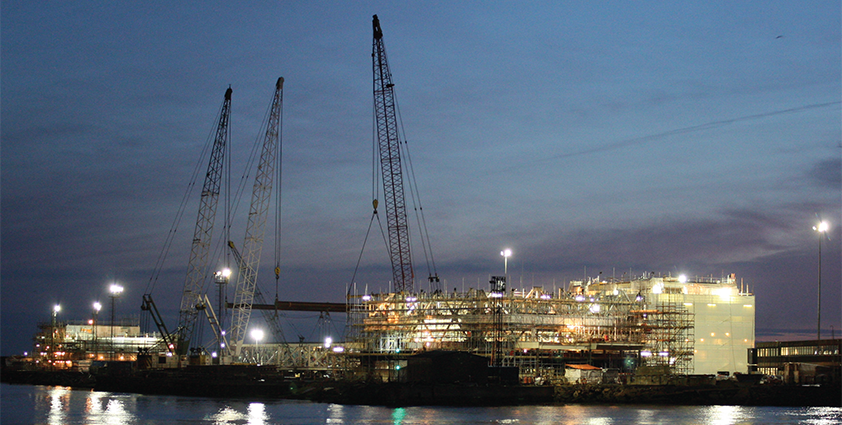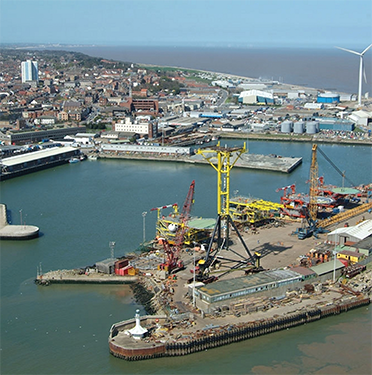
SLP Engineering
New beginnings
SLP Engineering is a company with over 40 years of history in the offshore oil and gas industry, providing turnkey solutions in accommodation modules, process platforms including minimum facilities platforms (MFPs) and offshore substations.
To date it has worked on several major projects, including the delivery of an accommodation module to the Norwegian sector of the Valhall oil field. With the support of current owner Smulders Group it aims to make its home base of Lowestoft, UK, a centre for substation development technology in addition to continuing its long association with the oil and gas sector.
Since first established, the company has been under the ownership of numerous large contracting firms such as Wimpey and Odebrecht. However, it became independent in 1999 through a management buyout and since then has grown its activities until, in 2009, the company employed 1400 people and had an annual turnover of £150 million.
Paul Thomson, the new CEO of SLP, goes into detail about what happened next: “In 2009 the company had to call in administrators because of a dispute with an international customer that left it with a £29 million deficit. However, even in administration the company completed and delivered a 4000 tonne accommodation module to the Valhall field, completed a 1200 tonne offshore substation for the wind industry and completed hook-up activities on three offshore platforms. Then, in August 2010, the business was purchased from the administrators by the Smulders Group, a Dutch group that specialises in large scale steel construction for the offshore industry with a particular focus on offshore wind farms.”
SLP’s Lowestoft base contains a full complement of engineering and procurement offices, bulk storage facilities, fabrication workshops, construction areas, and blasting and paint shops. These allow the company to offer a full range of design, manufacturing and delivery services as well as after sales support.
 When engaging with clients, the company likes to take a close yet open approach that allows for the free exchange of ideas between the two parties. A client will state what they want and require from their product and, utilising its extensive history and know-how, SLP will create the MFP or accommodation module that best fits the customer’s request whilst also satisfying all of the health, safety and environmental (HSE) regulations that need to be followed.
When engaging with clients, the company likes to take a close yet open approach that allows for the free exchange of ideas between the two parties. A client will state what they want and require from their product and, utilising its extensive history and know-how, SLP will create the MFP or accommodation module that best fits the customer’s request whilst also satisfying all of the health, safety and environmental (HSE) regulations that need to be followed.
“With our in-house engineering, procurement, installation and construction (EPIC) capability, SLP can work from functional specifications and develop designs with in-built constructability,” explains CFO John Lawrence. “This minimises the gaps in the production process that are commonly seen between separate design houses and fabrication contractors. The early procurement of key, long-lead materials and equipment also benefits from the close working relationship between engineers, procurement officers and construction team. Most importantly, it means an assured quality is built into the whole process.”
Once the initial order has been delivered, SLP is able to provide follow-on support in the form of technical studies and offshore extensions for existing facilities. For example, SLP has recently completed a number of studies on existing platforms, confirming the safe use of heavier helicopters and looking at increasing both design life and output capacity through additional wells, flow lines, proppant filters and process equipment.
More recently it has also been looking to move into the offshore wind energy industry. There are already a number of local wind farm developments that have seen the involvement of SLP, including the wind turbine at Ness Point – only yards from the company’s facilities – and the Thanet Offshore Wind Farm, for which it built the topside to the substation. It was also a founding member of Scira, an organisation that is developing Sheringham Shoal wind farm off the north coast of Norfolk.
John explains that the move into this industry was an inevitable one: “Many years ago SLP determined that the obvious next move for diversification of its offshore technology was the renewable energy business and offshore wind in particular. We see substations for offshore wind farms as natural products for us as they are fundamentally the same as MFPs with similar EPIC challenges, and definitely within our territory.”
With its parent organisation Smulders Group being itself heavily invested in offshore wind technology, SLP is ideally situated for the Smulders Group to enter the UK market in time for Round 3 developments. Meanwhile, the symbiotic relationship sees SLP benefitting from the financial stability provided by a large business, wide scope of knowledge possessed by sister subsidiaries and the business expertise of the group’s corporate advisors.
In both the oil and gas and offshore renewable sectors, upcoming prospects for the company will focus less on turnover and more about the drive behind each project. For example, contracts in politically high-risk areas will be carefully assessed and projects will be selected based on their suitability for the company’s facilities.
With a strong strategy in place, Paul concludes by expressing confidence in the future for SLP: “As the early, original accommodation for platforms in the North Sea and elsewhere fall behind HSE regulations, there will be a growing market for replacements and refurbishments. As the smaller operators take the place of the majors in the North Sea to exploit dwindling reserves of hydrocarbons the demand for quick and economical MFP based solutions will grow. We are in a great position geographically to cater for the burgeoning wind farm business and also in terms of being ready to start afresh with new shareholders, a great workforce and all the experience and technology we need to meet the growing opportunities.”
SLP Engineering
Services: Offshore engineering and contracting